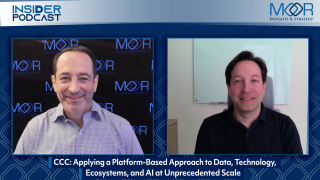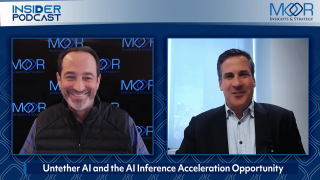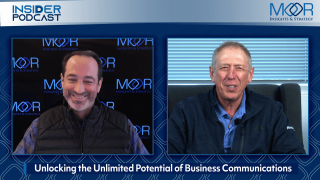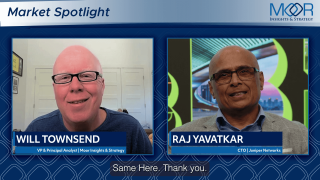On this episode of the Moor Insights & Strategy Insider Podcast, host Patrick Moorhead is joined by Dr. Jay Gambetta, IBM Fellow and Vice President of IBM Quantum. Their conversation covers:
- The recently published paper in the journal Nature from IBM and Berkeley that proves a noisy yet powerful quantum system of today was able to solve a complex problem that a supercomputer could not.
- How the results of the paper show a clear path toward useful quantum computing in industry and demonstrate the power of combining error mitigation with 100+ qubit quantum computers.
- What sets the results of this study apart from other newsworthy calculations done by quantum computers.
- What enabled IBM — and no one else — to obtain results like these.
- What is available right now to IBM clients.
- How these results are related to the idea of “quantum advantage.”
- What’s next for IBM Quantum.
This is a fascinating conversation you don’t want to miss!
You can watch the full video here:
You can listen to the episode here:
TRANSCRIPT
Patrick Moorhead: Hi, this is Pat Moorhead with Moor Insights & Strategy and we are here for another Moor Insights and Strategy podcast here chronicling the evolution of IBM Quantum computing. Jay, it’s great to see you. It was awesome to see you in Paris. Here we are talking about research. How are you my friend?
Dr. Jay Gambetta: Yeah, it’s always good to speak to you. I’m doing well. Looking forward to the conversation.
Patrick Moorhead: IBM’s keeping me very busy. I was in Think in Orlando, I was in Paris at your partner network conference, and here we are again talking about research and it is incredible. Unless you are not paying attention to anything in Quantum, there was a huge research paper that IBM came out with, it was published in Nature. Can you talk a little bit about the significance? When I read through it, it seems really, really big.
Dr. Jay Gambetta: Yeah, so we’re really excited about this result. So I think there’s been lots of great work in science and Quantum computing, but now we’re getting to a point where we’re starting to do something that we cannot do with classical computing. And so what we showed on this was some type of problem, it’s a physics problem, but it’s a real problem. And we showed that we could start to look at this problem and use a Quantum computer to predict outputs that we could no longer do with a classical computer.
So I look at it as the starting line, we fired that starting gun and now I’m going to see the next few things that come out. And I think we’re entering this new phase, I call it the phase of establishing utility of Quantum computing. I think a phase one was we wanted to establish Quantum was cool, people wanted to research Quantum. Now we can start to, how do we get useful Quantum computing? How do we establish utility of Quantum computing? And I think of this as the first step. And there’ll be many more and I’m really excited to see what our community of users and people think about this and what they extend to try different examples as well.
Patrick Moorhead: Yeah, I’m glad that I saw that, and I’m not even a scientist. But these are a lot of the questions that I get. And my superpower is not creating Quantum algorithms, it’s explaining it to people and predicting when they can rely on Quantum computing or elements of Quantum computing, most likely mixed with traditional computing to add value. And it seems like we’re on this path and we have a point of proof here. Am I reading that correctly?
Dr. Jay Gambetta: Yeah. So think of it as the first step, right? So we’ve done these great experiments where we’re seeing Quantum effects, we’ve seen many different published papers. But everyone wants to know when is it going to be useful, when am I going to see an industry application? I don’t think we’ve got an answer for that just yet, but the first step to getting that is, when can I do something on a Quantum computer that it’s difficult for me to do on a classical computer? And what we’ve seen here is we’ve seen this simple calculation calculate some property of a problem which we can describe. It’s a magnetization problem. And we’re saying can we calculate this property? And then we’ve employed these advanced techniques of dealing with the noise like error mitigation, error suppression. And that’s allowed us to get a result that seems to be behaving better than our best classical approximate methods in giving us more accuracy.
And so I like to think of it, as I said before, we’ve got a tool. How do we use this tool? How do we actually extend this tool? This is what we need to do and we need to get more and more demonstrations. And yeah, I look at it, as I said before, we’ve launched the race, how do we think of different examples? How do we keep making progress? But this is significant in that it’s 127 qubits and it’s 60 depth long. And so you think of that as a volume of computational space that we’re doing on a Quantum computer, and that’s really, really pushing us to a limit that it’s just not possible to start to think of classical computers to be able to model it.
Patrick Moorhead: Yeah. That’s significantly different from the papers. Important stuff, important work up to this point. But that’s fundamentally different. And I’m super excited about it because, again, I’m trying to translate the benefit to businesses and also to reinvigorate investment in Quantum.
So this is uniquely IBM. I know IBM has a lot of partners, but how has IBM been able to do this when others haven’t? I have read papers that kind of said it was doing what this paper did, but I think upon analysis it didn’t actually do that, wouldn’t want to use the word… I mean debunked sounds hard, but this seems like the real deal. How is IBM able to pull this off?
Dr. Jay Gambetta: So core comes into the hardware. We’ve invested so much time in packaging errors to make our hardware good, and this takes a lot of investment. But then on top of that is the theory, is the practice, how to deal with errors, and we combine these two.
So what we did is we ran this problem and we actually didn’t go and test it against simulators. We actually found a partner, and the partner tried to come up with simulators to test it and it created this nice dynamics between us, who are only interested in pushing our hardware, and the simulator, our partner, on how they can make improvements. And they’re pushing each other against and allowing them to keep making progress.
And so the simple answer is the combination of all our efforts. I think if I look at the most important, the Eagle processor breaking a hundred qubits, the latest revisions to that that brought the coherence, they’re the main one. And then all the work since 2017 that we’ve been developing to define this process we call error mitigation. And so what it is the combination of this theory with this hardware to do something that is starting to enter into this utility phase we talked about before.
Patrick Moorhead: It’s interesting and I’ve written this and talked about this before, one of the things that I find unique about the Quantum roadmap is, well first of all, anything that’s in research, typically they don’t actually have roadmaps. That’s a little bit new for me. I mean, there’s goals but not things you put on a slide with dates. And I think, and I’ve been in this industry over 30 years, first time I’ve seen a roadmap that continuously has hit the dates. And I think I’ve mentioned that to you at dinner before, I’m still kind of wondering how this comes together. I think part of this is IBM’s commitment to Quantum that goes back at least a decade, but also I think the full stack approach helps as well. And even you graciously gave me an invitation to Paris if you’re a Quantum partner network summit and there I learned this network effect of people working together as a community to learn best practices. So those are the things that I think are very different, aside from the whole stack that you’re looking at.
Dr. Jay Gambetta: Yeah, I couldn’t agree more. I often say we want to create an industry, not just a business. Obviously I want to make a product and make it really well, but as we’re going to go forward and the other announcement that we just made, how we’re investing towards even a future phase of a hundred thousand qubits, this is our commitment that we want to keep pushing that research, that roadmap, but to keep pushing ourselves to make these bigger, more powerful Quantum computers.
And the other part we didn’t touch that I find a lot of value for me personally, from the partner forum, that user feedback. And so we always have this tension in everything we do. We have our vision, our roadmap, but how do we adapt it with what our users are doing? And what I saw at the partner forum we were just talking about is the excitement of these new results and the excitement of these outcomes, what does it mean for us to start to think of applications and how we going to use Quantum computing as we go forward.
Patrick Moorhead: So we talked about reduced error rates, error mitigation and over a hundred qubit systems. When are these capabilities going to be available to clients?
Dr. Jay Gambetta: So that’s another thing. The system that we actually use to run this paper, we already give to our clients. It’s one of our systems that our clients already have access to. Yes, internally because we know a lot about our systems, we can use them, I would say a little bit better. And there is a little bit of gap on how to apply that error mitigation and those techniques and that’s what we’re working on and reducing that gap through both better education, but more importantly I want to make the way you run a Quantum computer, I call it frictionless, but how do I integrate these techniques that we discovered in the research so that they can just be an option for our clients and partners to use it.
That takes a little bit of work. You got to get robust, you got to get it more productized. So we’re working towards that. So today, yes, the clients could go do it, but they would have to go do all the error mitigation, all that themselves. And as we get more advanced in how we can calibrate robustness and all these into what we call the primitives or the fundamental APIs, I imagine a future where these are just options and a client can explore different options and we will handle the noise as best we can through our software and error mitigation so they don’t need to worry about it. And this is what I’m hoping to build out towards this sort of future of just easy to use Quantum computing such that from the end user, a user just wants to have access to Quantum computers, classical computers, and they want them to work.
Patrick Moorhead: Right, yeah. Everybody wants optionality and I’ve seen a lot of research based Quantum computers go through the labs. I was told that the privilege, I was one of the first people to walk through Poughkeepsie where you actually had production systems the client had access to. By the way, a security guard was walking within 10 feet from the group I was with. So it must be pretty-
Dr. Jay Gambetta: The system is actually in Poughkeepsie as well.
Patrick Moorhead: Okay, there we go. And like I saw at partner network, partners out of Japan in the Cleveland Clinic that actually have on on-premises capabilities as well. So you add that to the IBM Cloud, the ability to get access. It seems like you’re not making the decision for your clients, you’re letting your clients make that decision or help you in that.
Dr. Jay Gambetta: Yeah, so the Poughkeepsie data center, I think it’s our first example of data center. There’s like 22 systems there and you could have seen them all laid out. In that facility we can control the air conditioning, we can control all the stability. So those systems are more compact, and so you could walk in and you could touch, that’s probably why you had the security guards and that following you. Whereas the ones that we’ve developed for the clients, we put them in a nice glass box. One aspect of that glass box is to look good, but the other, it provides security and also the ability for us to control the stability of the system.
And so depending on whether our clients want to use in the cloud, which I think is where most value and most clients want to go, they can use our systems over at Poughkeepsie. Or if they really want an on-prem system, which is emerging because if you want to start… which is emerging for interesting research questions, because if you want to start exploring classical and Quantum working together, maybe you want to put your on-prem next to some classical computing so you can actually start to have lots of the data going between them at the rates you want. You can not be limited by bandwidth and things like this.
So I’m seeing a lot of excitement, which I call middleware for Quantum. How do we make this software stack that can talk to both of them? And the other thing that we kind of announced but we didn’t touch on it, is with this result and the sort of setting this path towards utility, I’m also working towards all the systems we have being a hundred qubits or more. So one of the things we want to commit to is now we’re in this new phase, how do we build education on this phase? How do we build more use cases once you’re in this utility phase? And so I want to move all of our systems that we’ve had, like we have few systems that are running billions… What is it? 4 billion executions. They’re all like five and say seven and the 27 qubits, I want to move every system by the end of the year to over a hundred qubits. And that’s because we believe so strongly we’re in a new phase and we want to see what people and our community can do with them.
Patrick Moorhead: I love it. And those are systems with the enhanced error mitigation.
Dr. Jay Gambetta: Error mitigation can be built into the primitives.
Patrick Moorhead: So I’m going to go a little bit big picture now. So we have systems available with reduced error rates, with error mitigation. We have middleware to connect to just about anything, including classical computers. In fact, that’s one of the main reasons for it. I see partners in your ecosystem just trying to make it easier for clients to tap access here. What does this mean, big picture? This is a pretty big deal holistically, isn’t it?
Dr. Jay Gambetta: I think we’re, in my view, the future of computing is not going to be without Quantum. So future of computing is going to be accelerators that do different topics. We’ve all seen the excitement of AI over the last six months that have come out, a bit less even. But I think of AI as innovation for the future by using the past. So I imagine a future, you’re going to have AI, you’re going to have Quantum, but Quantum allows us to calculate what we couldn’t do. So it brings future calculations, future innovation. So how we combine these two, I think these are open great areas to look. I think it’s the most exciting time to be in computing because now it’s completely different. And how we use Quantum, how we use ai, how we use traditional computing, it’s going to be much more driven by use case, by applications, by trying to explore something different.
So if I was just getting into computing, I would say right now, this is the time I would want to start. Obviously I’ve been working on Quantum for a long time, but if you jump in and you work out how all these things come together, there’s a lot of potential for the future.
Patrick Moorhead: So you’ve created a phrase that I really like. It’s called Quantum utility. And it’s so funny, I was racking my brain and when I heard about Quantum Advantage, this is different from Quantum Advantage and I’m glad you’re calling it something different because it is different. Can you compare and contrast those two terms?
Dr. Jay Gambetta: Yeah, so we wanted to call it Utility because we wanted the focus to be on starting to do something useful. And I think the biggest difference between Advantage and Utility, Advantage will apply to some type of problem. I think Advantage should come from the user. If I’m a, I don’t know, an industry, a chemist, I’ve now got a Quantum Advantage for doing my problem. From us that are providing the fundamentals, we want to provide the tools that have Utility.
So I think of Utility as almost a phase or an era and these machines are getting to that phase. And so now it’s, I think, up to our community of users, academic researchers, to work out under this set of assumptions or under this set of constraints or under this use case, do you see an advantage of using Quantum. But think of Utility as a new era. I think the previous era was about establishing, as I said before, Quantum was cool. This era is of using these processes that are in the Utility to look for different use cases where I can get an advantage over classical. And then in the future we’re going to have, we’ve talked about it before, but this vision that we have for Quantum centric supercomputing. Where we’re already working on because we want to get to systems of a hundred thousand qubits and there’s some really tough research questions to get there.
But I like to think of those three phases and what this paper we’re talking about today is started this center phase and we need to get many different demonstrations, applications, uses, develop the middleware so we can set ourselves up for this future.
Patrick Moorhead: So I love that you’d put this in a structured format. At least what I’ve learned is anything that’s difficult to explain to anybody helps to have phases. And you talked about phase one being the Quantum is cool, establishing it, talked about-
Dr. Jay Gambetta: And the community.
Patrick Moorhead: And the community, the second phase that we’re in right now is all about Quantum Utility. And what about phase three? What does the future look like again, can you extrapolate on that a little bit?
Dr. Jay Gambetta: So Utility, we have to do these things like error mitigation things to deal with it. The future, I imagine, we got full error correction and it’s just like a Quantum computer is basically, look, you send your program, it executes without errors. And so for that level, we need a certain size. We need also that Quantum computer to work with classical computing to simplify all of that. So I think of three things that are going to enable this future.
The first is modularity to allow us to scale. And that’s a hardware and even a software statement, but predominantly hardware. If you look at our controls and all these type of things and you ask, can we scale today’s controls or today’s cryogenics up to that size, there’s some engineering scientific questions that we need to overcome. So starting to write them down and showing how you’re going to scale to that peak.
The second is Quantum computing and communication. Quantum communication are kind of being separate fields, but inside your processors, your classical processors, you’ve got interconnects, you’ve got processes. So to allow us to scale, we’re going to have to bring communication and computation together so that we got processors connected to other processors with both classical and Quantum communication links. And then we need to get this middleware for Quantum that we’re touching on that allows us to use all these, and I even imagine in this middleware for Quantum using classical computing to do things like more efficient error correction and make it this path from today’s error mitigation to error correction.
So I think of this phase as Quantum centric supercomputers and I imagine that’s going to be a machine that’s powerful enough that it’s going to be like the largest supercomputers we have today in classical. This will be the next generation of a supercomputer.
Patrick Moorhead: It’s a lot of fun, and as industry analysts or educating the community, bringing value to it. And it’s been a lot of fun being along for the ride for so many years. I think this is either a year four or five that I’ve been crawling. It probably seems like a lifetime to you, but relatively new for me. But it’s fun to see the wheel of innovation turning so quickly at IBM and across its its IBM Quantum Partner Network. So appreciate your time. Thank you for meeting with me on the big day.
Dr. Jay Gambetta: No problem. Thank you.
Patrick Moorhead: This is Pat Moorhead with Moor Insights and Strategy, thanking everybody out there. You can learn more about this groundbreaking research paper that came out today. Check out our show notes and I’m sure we’re going to be doing a writeup on the Moor Insights and Strategy website. Thanks for tuning in wherever you are on the planet. Good morning, good afternoon, goodnight. Take care.




















































































